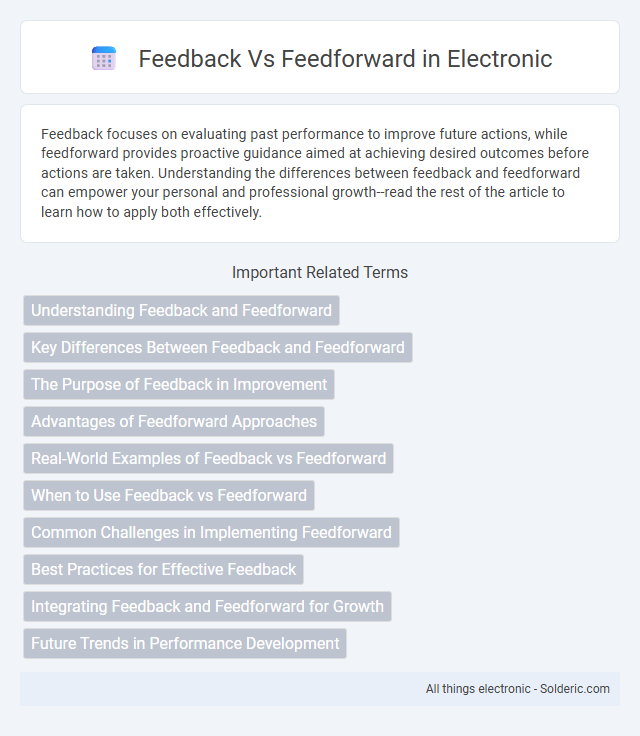Feedback focuses on evaluating past performance to improve future actions, while feedforward provides proactive guidance aimed at achieving desired outcomes before actions are taken. Understanding the differences between feedback and feedforward can empower your personal and professional growth--read the rest of the article to learn how to apply both effectively.
Comparison Table
| Aspect | Feedback | Feedforward |
|---|---|---|
| Definition | Information about past performance or behavior. | Guidance or suggestions focused on future improvements. |
| Timing | Given after an action or event. | Provided before an action or event. |
| Purpose | Correct errors and reinforce learning from past results. | Prevent mistakes and enhance future performance. |
| Focus | Past behavior and outcomes. | Potential future behavior and goals. |
| Examples | Performance reviews, error correction. | Coaching, goal setting, anticipatory guidance. |
| Impact | Helps in learning from experience and improving. | Encourages proactive improvement and motivation. |
Understanding Feedback and Feedforward
Understanding feedback involves analyzing past performance to identify strengths and areas for improvement, enabling corrective actions and continuous learning. Feedforward focuses on providing actionable guidance and suggestions for future behavior or performance, promoting proactive development and goal attainment. Both approaches enhance communication and effectiveness by addressing what has happened and what can be improved moving forward.
Key Differences Between Feedback and Feedforward
Feedback provides information about past performance to evaluate and improve future actions, while feedforward focuses on offering guidance and suggestions before an action is taken to enhance outcomes. Feedback analyzes results after completion, emphasizing corrective measures, whereas feedforward anticipates challenges and opportunities to shape behavior proactively. The core difference lies in timing and intent: feedback is reactive and evaluative, feedforward is proactive and developmental.
The Purpose of Feedback in Improvement
Feedback serves as a critical mechanism for performance improvement by providing specific information on past actions and outcomes. It allows individuals or teams to identify errors, reinforce positive behaviors, and adjust strategies to enhance future results. The purpose of feedback is to close the gap between current performance and desired goals, fostering continuous learning and development.
Advantages of Feedforward Approaches
Feedforward approaches provide you with proactive guidance focused on future performance, enabling continuous improvement and goal alignment before issues arise. By emphasizing actionable suggestions rather than past mistakes, feedforward enhances motivation and encourages innovation within teams. This method reduces defensive reactions, fostering a positive communication climate that supports ongoing development.
Real-World Examples of Feedback vs Feedforward
Real-world examples highlight the distinct impact of feedback and feedforward in performance improvement. Feedback often occurs in sports coaching, where athletes receive post-game analysis to correct mistakes, whereas feedforward is used in corporate settings, providing employees with proactive guidance before projects begin to enhance outcomes. Your ability to implement feedforward can lead to more effective growth by focusing on future possibilities rather than past errors.
When to Use Feedback vs Feedforward
Feedback is most effective after a task or project is completed, providing insights on performance and areas for improvement. Feedforward works best before or during a task, offering forward-looking suggestions to guide future actions and enhance outcomes. Your choice depends on whether you aim to evaluate past performance or shape upcoming behavior for optimal success.
Common Challenges in Implementing Feedforward
Common challenges in implementing feedforward include resistance to change, as individuals may be more comfortable receiving feedback about past actions rather than guidance for future improvement. Organizations often struggle with a lack of training and understanding on how to effectively deliver feedforward, leading to ineffective communication and diminished impact. Your success in adopting feedforward hinges on fostering a culture of openness and continuous learning that values proactive, future-oriented dialogue over retrospective criticism.
Best Practices for Effective Feedback
Effective feedback focuses on specific, actionable observations rather than vague critiques, ensuring clarity and relevance to your goals. Emphasizing positive behavior while identifying improvement areas encourages motivation and growth. Timely delivery and maintaining a constructive tone empower you to implement changes confidently and enhance performance.
Integrating Feedback and Feedforward for Growth
Integrating feedback and feedforward creates a powerful framework for continuous growth by addressing past performance while guiding future improvements. Feedback focuses on reflecting past actions to identify strengths and weaknesses, whereas feedforward offers actionable suggestions to enhance upcoming tasks. By combining these approaches, you foster a proactive learning environment that accelerates personal and professional development.
Future Trends in Performance Development
Feedforward techniques are becoming increasingly important in future trends of performance development, emphasizing proactive guidance and goal-setting over retrospective evaluations. Organizations are leveraging AI-driven analytics to provide real-time, personalized feedforward insights, enhancing continuous improvement and adaptive learning. This shift supports a culture of growth and resilience, fostering innovation and aligning employee development with dynamic business objectives.
feedback vs feedforward Infographic

 solderic.com
solderic.com